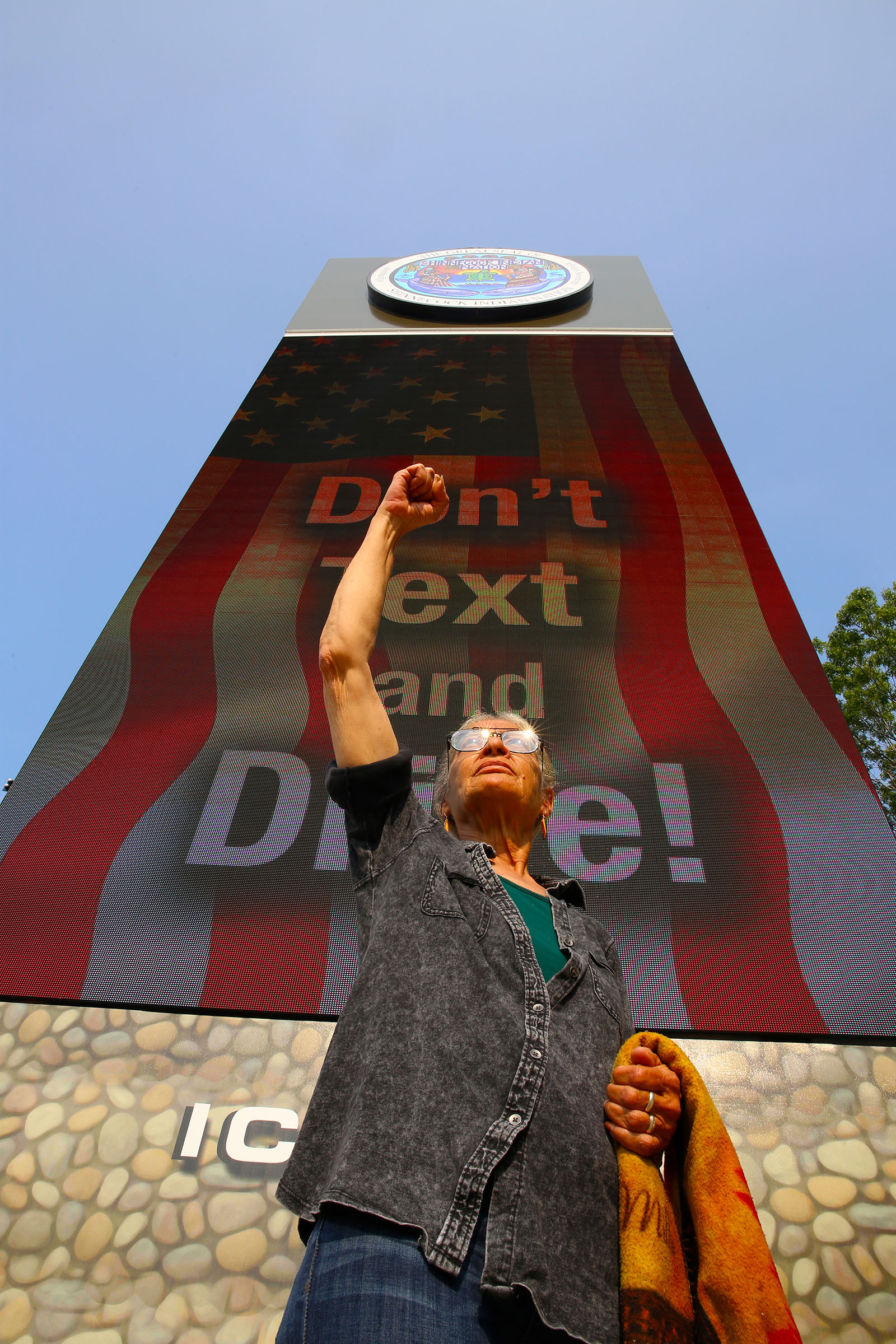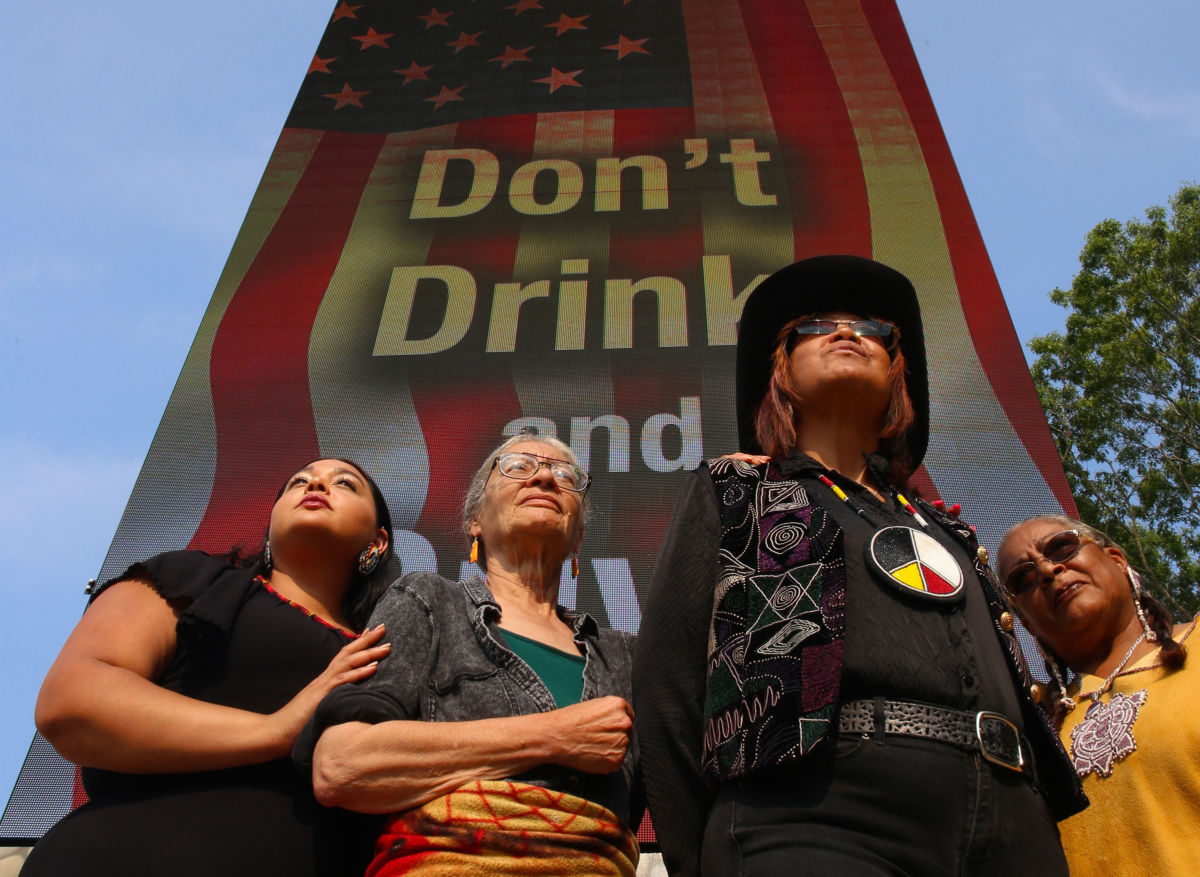Wealthy, white homeowners are outraged that the Shinnecock Nation has decided to erect two blazing 60-foot electronic billboards on their tiny patch of sovereign lands at the gateway to the Hamptons, a tony retreat for the rich and famous. Members anticipate that advertising income from the billboards will generate income for the Nation that will help pay for health and dental clinics as well as a community daycare facility.
The Hamptons residents’ anger is rich with irony. In many ways, it reads like an old-time teaching story from my tribe, the Ojibwe. These teaching stories function as parables that offer guidelines for leading a good life, including responsibility for family, the Earth and its inhabitants. In the Ojibwe worldview, water, plants and animals, as well as people are considered to be relatives and therefore deserving of care and respect. Some of our teaching stories are cautionary tales that feature a character named Waynaboozhoo. Half man, half spirit, Waynaboozhoo is often caught in his own trap of greed and insistence on interfering in the natural order of life. Waynaboozhoo’s spiritual nature may motivate him to act out of idealistic concern for others, but his human heritage usually interferes, inducing him to take too much and go too far.
Led by the same misguided forces driving Waynaboozhoo, the wealthy landowners in the Hamptons have curated and dominated the area, creating an illusory, bucolic retreat from the rapacious consequences of their own capitalism. The standoff between the Shinnecock and wealthy Hampton landowners is an allegory for the Faustian bargain of American capitalism that childishly assumes the biggest players will never face payback or repercussions as long as their money holds out. Moreover, it’s a spot-on example of the blissful ignorance afforded by white entitlement and classism forwarding the notion that some people are simply above the forces of nature.
Meanwhile, rich Hamptons landowners are condemning the signs as an eyesore.
“The town is appalled by what is going on. I mean we are outraged,” Southampton Supervisor Jay Schneiderman told CBS New York in a recent interview about the tribe’s signs. Schneiderman expressed concern that the signs would present dangerous distractions to vacationers from New York City headed to the Hamptons along New York State Route 27, also known as Sunrise Highway.
According to Schneiderman, the signs would be better suited for Times Square rather than the farm country of the Hamptons. This farm country is home to summer retreats owned by the super-rich, such the 62,000-square foot home owned by junk bond king Ira Rennert. David Koch of Koch Industries lives along Southampton’s Meadow Lane, dubbed Billionaire Lane by Forbes. Koch Industries, Inc. is the second-largest private corporation in the country. The multinational business is involved in fossil fuel development, refining, cattle ranching and other industries. Greenpeace describes Koch Industries as a major polluter.
By comparison, the approximately 700 Shinnecock tribal members residing on an 800-acre reservation in the Hamptons live below the federal poverty level. Information about annual income on the Shinnecock Reservation is not available in the 2010 U.S. Census. In 2000, however, median annual income reported by the Census was $14,055. Adjusted annual income in 2018 would be about $20,898. The tribe has faced years of opposition from locals to their various plans, including a casino and tax-free cigarette sales to generate revenue to help support community health and dental clinics, fix crumbling roads and build a daycare facility.
The signs are a good economic fit for the tribe, says Gordell Wright, a former Shinnecock tribal trustee. “They have a small footprint and won’t add any traffic, but will offer quick and consistent income,” he told Truthout.

The New York State Supreme Court has issued a temporary restraining order to halt construction of the billboards. The New York State Department of Transportation also issued a stop work order, citing a ban of advertising on state roads, according to CBS New York.
Shinnecock leaders, however, have ignored the orders, pointing out that as a federally recognized tribe, they are a sovereign nation with the right to govern themselves.
The dispute is ongoing.
“They (the electronic billboards) will completely change the character of our community we have fought long to protect,” Supervisor Schneiderman told CBS New York.
Other homeowners interviewed by CBS New York complained that the billboards will ruin the ambiance of the area.
For the Shinnecock, such complaints smack of hypocrisy and racism. Bryan Polite, chairman of the Shinnecock tribe, told 27east.com that rampant development by corporations and the super-wealthy — including condominiums, golf courses, mansions built on small plots of land and a massive cell phone tower — are the real eyesores responsible for ruining the vibe of the Hamptons.
Living with the often-poisonous results of capitalist ventures is an old story in Indian Country. Indeed, the fallout goes far beyond ruining the vibe of a place. The tally of deadly examples of environmental racism on Indigenous lands is nearly endless.
Long History of Pollution on Native lands
The Navajo Nation is still fighting with the federal government and mining companies to clean up their lands after years of uranium mining. Cancer rates doubled for the tribe from the 1970s to the 1990s as a result of uranium contamination. Today, about 40 percent of Navajos lack safe, uncontaminated running water.
The Fort Berthold Reservation, home to the Mandan, Hidatsa and Arikara Nations, sits in the middle of the Bakken oil patch in North Dakota. People there live next door to roaring gas flares. The rotten egg odor of fracking chemicals permeates the air as the earth rumbles from fracking drilling operations. Residents complain of headaches, asthma, neurological damage, cancer and other ills.
The Alberta tar sands straddle traditional hunting and gathering lands for the Cree Nation. Saltwater and chemicals used in extracting oil from the land are polluting water and poisoning fish and game on which the Cree rely for food. Canadian Prime Minister Justin Trudeau is walking back on his promise to protect Indigenous communities from greedy, influential oil companies.
The Standing Rock Reservation in North Dakota, home to the Lakota people, was ground zero for environmental racism driven by capitalist greed and development. Although the Water Protector camps of the NoDAPL movement — with their rallying cry of Mni Wiconi, “Water is Life” — failed to halt the construction of the Dakota Access oil pipeline under Lake Oahe, the tribe’s sole source of drinking water, the movement drew worldwide attention to the unsustainability of capitalistic ventures like fossil fuel development.
“Standing Rock is what woke you [non-Native] people up, but we have known for a long time that the colonial capitalism corporate model is attacking this world,” Robert Blake, founder of the solar installation company Solar Bear told Rolling Stone.
The Standing Rock tribe’s bold move to assert their tribal sovereignty and stand up against fossil fuel corporations and the federal agencies that support them has also inspired other tribes to resist harmful development and use federal laws to their favor.
Tribal Resistance Grows
The Shinnecock Nation’s decision to erect billboards on their sovereign land is also an act of resistance against mainstream capitalist developers that have long ignored the Nation’s presence.
In describing his tribe’s electronic sign project in the Hamptons, Shinnecock tribal chairman Polite said in an interview with 27east.com, “Living in the richest community in America, it’s unacceptable for us to be in poverty, in any way. We’re not going to have it anymore. It’s done. The town can like it, lump it, whatever.”
Former Shinnecock tribal trustee Wright concurred, pointing out that Hamptons residents have interfered with their efforts to fight poverty in the past as well.
“Every time we’ve tried to create some economic development for our tribe, the townspeople stand in our way and complain our plans are detrimental to the Hamptons,” Wright told Truthout. “Southampton police charged us with violating state law when we sold tax-free cigarettes. Townspeople blocked our casino in court. They promised to help us come up with an economic development plan, but it’s never happened.”
Of course, Wright said, Hamptons residents do not seek the Shinnecock Nation’s approval when they build new mansions or condominiums.
“As long as we were ‘good little Indians’ and didn’t make any waves, they were okay with us. They want us to consult them on our plans, but they’ve never consulted us on any of their development plans,” Wright said.
After years of submitting documentation to the Bureau of Indian Affairs, the Shinnecock received federal recognition by the federal government in 2010.
“We’re not your Indians anymore; we’re a sovereign nation,” Wright said.
Indeed, the Shinnecock describe their new billboards not as signs, but as monuments to tribal sovereignty. The structures are intended to send a message to the entire Hampton community that this is only the first in a series of tribal development projects.
Lance Gumbs, vice chairman of the tribe’s council of trustees, told 27east.com that the monuments also send a message to the Shinnecock people that they can, indeed, act independently.
Although the billboards’ alleged negative impact on the Hamptons townspeople is pretty minor, especially compared to all that Native peoples have endured, there is something righteous and deeply satisfying in hearing rich folk rail against the tiny Shinnecock tribe’s gaudy signs despoiling their rarified retreat.
Perhaps for the first time, the top of the Hamptons’ capitalist food chain is experiencing a bit of retribution for their actions.
If those old-time Ojibwe stories are any indication, this won’t be the last piece of payback in the Hamptons. Like Waynaboozhoo, even the super-rich will eventually learn that no amount of money will insulate them from their connection and responsibility to community and the Earth.
Join us in defending the truth before it’s too late
The future of independent journalism is uncertain, and the consequences of losing it are too grave to ignore. To ensure Truthout remains safe, strong, and free, we need to raise $44,000 in the next 6 days. Every dollar raised goes directly toward the costs of producing news you can trust.
Please give what you can — because by supporting us with a tax-deductible donation, you’re not just preserving a source of news, you’re helping to safeguard what’s left of our democracy.
